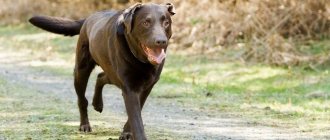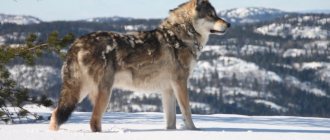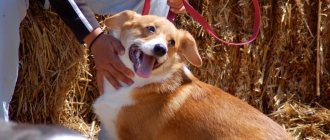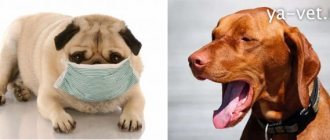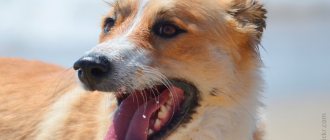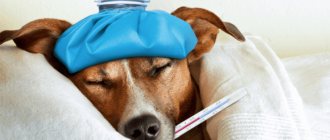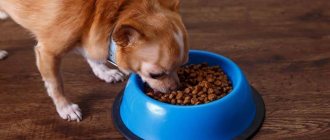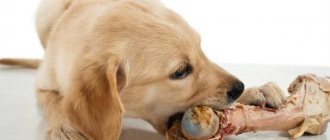Associated symptoms and behavior of the animal
Even small cracks in the pads of the paws can cause serious discomfort to the dog. This manifests itself in the following signs:
- afraid to step on paws;
- advances, but limps;
- Constantly licks his pads.
There are cases where the cracks were so deep that the pet whined with every movement or even refused to stand on its feet again. Each case is individual, so a visual examination of the animal and collection of complaints from the owner’s words are of great importance in determining the cause. Only then will it be possible to exclude or confirm the following reasons:
- Weather. In winter, dogs often get corroded pads on their paws due to the “chemicals” that are sprinkled on the roads. Even ordinary salt, which in many regions is still sprinkled on roads against ice, can cause serious harm to a pet’s paws. During this period, the animal needs special care - after a walk, thoroughly wash its feet with warm running water. At the initial stage, a white coating appears on the pads, under which small cracks may be hidden. To prevent this phenomenon, it is recommended to treat the pads with special wax in winter, which is sold in every veterinary pharmacy.
- Poor nutrition. The most common cause of deep cracks in the paw pads of dogs at any time of the year. Breeds with allergies are at risk (Shar Peis, Mastiffs, Pugs, English and French Bulldogs). Here you need to exclude two options - an excess of protein in the diet or a lack of it. The problem is solved by selecting food/products based on the pet’s accompanying symptoms and behavior. Much attention is paid to coat color and shedding.
- Injuries. A common occurrence among hunting breeds and dogs that often walk in the forest. You can get hurt on needles, sharp branches and even some grass. Such wounds appear on the pads in the form of small cracks, which you notice only when the pet begins to limp or lick the affected area. Only deep cuts are dangerous; small ones heal on their own within 1-2 days. During this period, it is better to give the animal a rest, reducing the walking time by at least 2 times. For any cuts, it is recommended to treat the area with chlorhexidine solution.
We also do not forget that age also plays a big role, so problems with paw pads are diagnosed in older dogs much more often than in young, active individuals.
Cover the pads only for deep cuts. Dogs successfully lick small cracks on their own!
It is best to show your pet to a veterinarian in order to determine for sure the nature of the appearance of cracks on his paw pads. If this is not possible or you want to immediately help your animal, then you can use the following means:
- Ointment "Zorka", which is sold only in veterinary pharmacies. It is considered the most effective healing agent used for cuts, cracks and deep wounds on the pads of the paws. It can also be used as a preventive measure in winter after each walk.
- For deep cuts, it is recommended to thoroughly rinse the affected area with warm, running water, wipe dry and treat with chlorhexidine solution. Next, a gauze bandage soaked in levomekol is applied to this place. It must be secured carefully so that the animal cannot remove it. Change the bandage 2 times a day after each walk until complete healing.
- Special wax. An excellent tool to prevent cracks in the future. It is used in winter, when there is a high probability of the pads being corroded by saline solutions and de-icing chemicals. It is applied in a thick layer, which allows you to form a water-repellent film around the pad. After each walk, the wax is thoroughly washed, and the paws are treated with baby cream.
Some owners find a way out by buying/sewing special shoes for their pet, but, unfortunately, not every dog wants to walk in such uniform.
Loading…
Even experienced dog breeders do not always imagine the stress that the pads on their pets' paws experience. Meanwhile, they are very significant. There are known cases when apartment dogs, unaccustomed to stress, literally wore the pads on their paws to the pulp after just a couple of hours of walking on the asphalt. No less unpleasant and dangerous are cracked paws in dogs.
- They are natural shock absorbers that reduce the load on the animal's skeleton. This is especially important for service dogs, who sometimes walk or run dozens of kilometers in a day.
- Dogs can only sweat (!) through the pads on their paws. In other parts of their body there are no sweat glands at all.
- There are cases when some dogs ' pads are so tender that they simply physically need to wear special shoes for walks.
- Dog paws are extremely sensitive to all types of chemicals. Remember that if you regularly treat the enclosure with disinfectants, or wash the floor in the apartment using chlorine bleaches, the treated surfaces must be thoroughly rinsed with clean water. Otherwise there may be problems.
- Oddly enough, any deviation in feeding is primarily reflected in the condition of the paws. The pads sense pH changes in the body so subtly that they can compete with litmus tests in this matter.
- In addition, the condition of the paw pads correlates well with a lack of zinc in the diet. If it is missing, cracks on the paw pads of dogs become constant “companions” of the animals.
We have already talked about some of the reasons, but one should not think that these are all existing predisposing factors. Many dog owners prefer to play with their pets by throwing them a ball or a stick. Unfortunately, hard-surfaced areas are often chosen for this purpose. When a dog, accelerating in a rapid rush, tries to stop abruptly, it skids. The paw pads are severely injured.
Non-communicable causes
Other reasons can also cause itching and redness in the groin in men.
Allergies
The thin skin of the inguinal folds and scrotum is susceptible to many allergens. It can be:
- food products;
- detergent components;
- linen fabrics;
- lubricant for sex;
- condom material.
When the factor that caused the allergy is eliminated, improvement occurs. Tests for immunoglobulins and the immune status of the blood help to identify allergies.
More often, allergies occur in the form of atopic dermatitis - dry redness and peeling in the groin in men; If small blisters appear against a background of redness, they speak of eczema.
Prickly heat
A groin rash in men and itching can be caused by wearing tight or synthetic underwear. The condition is aggravated by staying in a hot atmosphere, long trips, when there is no opportunity to wash with soap and allow the body to breathe.
The essence of prickly heat is that sweat is actively secreted, and the sweat glands are clogged with sebaceous secretions and skin flakes. White nodules and red spots appear in the inguinal folds.
Systemic diseases
Diabetes mellitus, liver and gallbladder diseases, kidney failure, and psoriasis can provoke itching. In all such cases, there are other important symptoms of these ailments, and itching all over the body, and not just in the groin. With iron deficiency anemia, itching intensifies during contact with water.
Psychological reasons
In some cases, the cause of severe itching in the groin in a man may be general nervousness or obsessive-compulsive disorder. Scratching injures the skin, a streptococcal infection gets into the scratches, and inflammation begins.
Exposure to irritants
Signs of pathology appear after contact - the sore cracks as the skin is damaged. Damage can be caused by both chemical compounds and physical factors - cold, high temperature. In hunting breeds of dogs in the fall, widespread skin maceration is observed - the skin between the toes softens due to the dogs' prolonged stay in water and on wet soil.
Softened and damaged skin becomes most susceptible to bacterial infection. Purulent inflammation quickly develops, as a result of which the dog develops non-healing cracks and ulcers. Animals begin to limp, the pathology causes pain - the pet can constantly lick its paw, which only increases the pathological effect.
In winter, the pads on dogs' paws crack due to contact of the crumbs with anti-icing agents.
For treatment, it is necessary to prevent the dog from coming into contact with irritating substances. The paws are washed with warm water; it is better to use a solution of potassium permanganate or furatsilin. You should not use alcohol or other irritating antiseptics, as this will only intensify the pathological process.
To speed up healing, creams and ointments with antiseptics and anti-inflammatory drugs should be used. A bandage is applied on top, which is secured with socks so that the pet cannot chew and remove the product. Treatments are carried out daily.
[custom_ads_shortcode2]
Mechanical damage to the crumb
Paw injury is a fairly common injury in dogs. Animal walking areas are often strewn with sharp metal objects and broken glass, and there is even more of this in undesignated areas. Mechanical damage to the paw pad is accompanied by the following clinical changes:
- severe pain reaction;
- lameness, suspended limb;
- the dog licks the wound;
- bleeding.
Upon examination, the dog reveals a wound on the flesh or between the toes, from which blood may be released (depending on the depth of the damage and the degree of penetration). There is swelling around the affected area, and often the entire distal part of the paw swells. The area is red and hot. The pain is very pronounced; some dogs may bite the owner during examination due to inept manipulation.
First of all, the owner is required to stop the bleeding. It is necessary to apply a tourniquet to the wrist (tarsus). Then the wound is treated with hydrogen peroxide - active oxygen will lead to coagulation of plasma proteins and blockage of blood vessels. In addition, peroxide will help get rid of pollution and pathogenic microflora.
If there is no peroxide, then it can be replaced with any antiseptic solution - potassium permanganate, furatsilin, baking soda.
If there is heavy bleeding, do not wash the wound, as this will only increase blood loss. Instead, a pressure bandage is applied for 2-3 hours until the bleeding stops completely. At the same time, calcium preparations (gluconate, chloride) and vasoconstrictors (adrenaline, ephedrine) are administered intravenously. Cold has a good local effect - an ice compress is applied over the bandage, this will also reduce the pain reaction. In severe cases (large blood losses), intravenous infusion of plasma substitutes or blood transfusion will be required.
When the threat to life has passed, the wound should be treated for infection - washed with an antiseptic solution, antibiotics and sulfonamides are applied. A bandage bandage is applied on top. To prevent your dog from removing the bandages, you should wear socks. To speed up the healing of the wound from the second dressing, it is treated with ointments and liniments. Small wounds can be sealed with plaster or glue.
Hyperkeratosis of the paw pads
The disease is manifested by excessive formation of keratin, most often the paw pads are affected, and less often the nasal planum. The pathology develops against the background of other skin diseases or as a hereditary disorder. Old dogs are most susceptible to the secondary form of the disease, but the pathogenesis has not been precisely studied. Most often, hyperkeratosis occurs with plague, systemic lupus, various dermatoses, and exposure to a number of irritants.
The congenital form manifests itself as follows. The contact of the dog's paw pads with the surface of the ground is disrupted, as a result of which the abrasion of the crumb is greatly reduced. As the layer grows intensively, a layer grows strongly on part of the pad, at the border of which cracks often appear.
Clinical picture:
- paw pads are hard;
- crumb is brittle, cracked;
- soreness;
- lameness is noted while walking;
- often changes affect the nasal planum.
To clarify the diagnosis, a skin biopsy is required to determine the causes of the disease. If the pathology is caused by other diseases, then they should be treated. But without local treatment, functional restoration will not occur.
It is impossible to completely stop excess keratin deposition, so it should be removed promptly. The dead horn is removed with unexpressed pain using scissors. To make the procedure easier, it is recommended to first soften the crumb (immerse in warm water for 5-10 minutes) on the paw. Special lysing agents (tretinoin gel) are used, which are applied to the crumb in the form of a compress for 10 minutes, after which the horn is removed mechanically.
Ulcers and cracks are treated with antiseptic ointments. Purulent inflammation will prevent healing and prolong the pathological process. Daily treatments are done for 10-14 days, then the break between treatments is extended to 3-5 days. But treatment cannot be stopped even after the symptoms disappear - increased keratin formation cannot be stopped until the underlying cause is eliminated, and in the case of hereditary factors this is impossible.
To determine the causes of cracks in the paws of dogs, a complete diagnosis of the animal is necessary; the etiology may be hidden both in local effects and in damage to other organs. Taking into account the diagnosis, rational treatment is selected. The owner subsequently needs to monitor the pet’s health.
[custom_ads_shortcode3]
Crack on a dog's paw
The pads on the paws are a delicate organ that is susceptible to injury. Despite the fact that this is the working part of the limb, which always interacts with the surface, very often cracks, cuts, increased dryness and other unpleasant phenomena can be found on the paws.
Often, even experienced dog lovers do not know how to treat a cracked paw pad in a dog. Therefore, if you see such signs, we recommend that you contact a veterinary clinic.
[custom_ads_shortcode1]
Contagious diseases that cause itching in the groin
First of all, these may be.
Scabies
It is characterized by two-point rashes all over the body. There are most of them in the skin folds, including the inguinal folds. A special symptom is that the skin itches more at night.
Pubic lice
Even a condom does not protect against them, since these insects live in the hair surrounding the genitals. With a careful examination through a magnifying glass, a urologist-venereologist can see them.
Fungi
Most often these are fungi of the genus Candida, transmitted through sexual intercourse. Along with redness and itching in the groin, the man will have inflammation and plaque on the head of the penis, and white discharge from the urethra.
Sometimes irritation in the inguinal folds is caused by ordinary saprophytic skin fungi. The spots in a man's groin will be in the shape of a ring, with swelling of the skin around the edge.
Other sexually transmitted diseases
Chlamydia, ureaplasmosis, and genital herpes occur after sexual intercourse with a sick partner. Unpleasant sensations in the groin are accompanied by pain when urinating and discharge from the urinary canal. The inguinal lymph nodes become denser.
In the photo: fungal rashes
Cracks in the paw pads of dogs occur for several reasons:
1. Delicate skin - some breeds are simply susceptible to this disease; only a qualified veterinarian can help solve the problem. 2.
Chemical exposure - skin reactions to various chemicals, for example, to various de-icing reagents, as well as to various detergents. During cleaning and disinfection, thoroughly wash surfaces with clean running water.
3. Improper nutrition - any deviation from the nutritional balance primarily affects the paws. Pads are an excellent indicator of possible health problems.
4. Dry skin due to lack of zinc in the diet. The solution is to add zinc-containing preparations to food, as well as replacing some meals with foods containing this important element.
[custom_ads_shortcode3]
Treatment of wounded paws if the dog is limping
If the animal, in addition to visible cracking of the paw crumb, also has lameness, self-medication is unacceptable. Indications for contacting the clinic are also swelling, redness, pain on palpation, redness of the pads, bleeding from the paw.
The dog should be shown to a veterinarian to rule out more serious problems - penetration of a foreign object into the deep layers of the skin, development of erosive dermatitis, purulent inflammation of soft tissues.
After identifying the problem, the veterinarian will prescribe treatment. Severe injuries to the soft tissues of the paws require surgical cleaning of the wounds from foreign objects, dirt, and dried blood. Antiseptic solutions are used to treat paw crumbs. In case of deep damage, the wound is additionally sprinkled with streptocide and sutured.
Anti-inflammatory ointments - Tetracycline, Levomycetin, Streptomycin - will help soften and relieve inflammation. If the wound is complicated by a purulent infection, Ichthyol ointment and Vishnevsky liniment are applied topically to the animal. In some cases, a veterinarian may prescribe a course of antibacterial therapy to prevent the spread of purulent inflammation to healthy tissue.
Multivitamin and mineral supplements in food help improve the condition of rough skin, reduce inflammation and accelerate tissue regeneration. In order to eliminate the deficiency of zinc and selenium in the diet, the animal is prescribed their preparations. The dose of microelements will be determined by a veterinarian. Complex vitamin formulations or adding pharmaceutical preparations to food in the dose recommended by the attending physician will help eliminate the deficiency of vitamins A and E.
A good therapeutic effect is obtained by enriching the dog’s diet with bone and meat meal, adding Tetravit and fish oil, Biotin.
To learn how to apply wax to your dog's paws, watch this video:
Cracks on the paws of dogs: causes and first aid
Walking on hard surfaces also has a significant impact on paw health. Choose parks where walking is allowed for outdoor games. Avoid paved areas and sports fields.
6. Cold climate. We all know that frost dries out the skin greatly.
The delicate coating of the pads is no exception. During winter walks, be especially careful with your pet's paws, avoid icy roads, and walk your dog in the snow. Moreover, roads in modern cities are covered with special chemicals, which also have a bad effect on the health of the limbs.
[custom_ads_shortcode1]
Here are some tips to help you before seeing a doctor:
- If possible, ensure that your dog does not lick its paws, as high humidity can make the situation worse;
- if suddenly the cracks begin to bleed, be sure to limit the flow of blood using gauze pads or a bandage;
- wash the wounds with a cotton swab dipped in hydrogen peroxide;
- if there is noticeable dryness of the skin, use any moisturizing cream for animals;
- walk your dog in special socks;
- make sure that the wounds do not rot;
- If you notice swelling, severe bleeding, or an unpleasant odor appears from the crack, contact a veterinary clinic immediately;
- do not self-medicate.
[custom_ads_shortcode3]
Preventing problems
Advice and recommendations from experienced dog breeders and veterinary specialists will help prevent the occurrence of a problem that limits the free and painless movement of your pet:
- Walking your four-legged friend should be done in a specially designated area, trying to avoid asphalt, concrete surfaces, and hard grass. Periodically, the walking area must be inspected and foreign objects removed from the site to avoid injury to the animals.
- In winter, when deicing agents are widely used, it is necessary to wear special protective shoes on the dog’s limbs. Your pet should be taught to wear boots from an early age. It is necessary, first of all, for owners of decorative and miniature breeds to pay attention to this issue.
- Before a winter walk, special wax, for example, “Let’s go for a walk,” will help protect the paw crumbs from cracking. The product will protect delicate tissue from the effects of adverse external factors.
- If the pet flatly refuses to walk in winter in protective shoes, as well as during walking in the summer, then after going outside the paws must be washed with pet shampoo. Then the soft tissue of the pads should be treated with an emollient cream, for example, “Children’s” or Vaseline.
- When washing indoor floors, do not use aggressive detergents, which can irritate the delicate skin of the pads.
- Trim your dog's nails in a timely manner, since when they grow excessively, soft tissue injuries occur more often.
- The diet of a pet predisposed to the problem of cracking of paw crumbs should be enriched with vitamins A and E, and the content of zinc and selenium in it should be monitored in recommended quantities. If necessary, add vitamin and mineral complexes to the food recommended by a veterinarian.
We recommend reading about a broken paw in a dog. From the article you will learn about the causes and types of fractures, symptoms of fractures of the front and hind legs, first aid for a pet, diagnosis and treatment.
Read more about rib fractures in dogs here.
Cracks in the paws of dogs occur under the influence of a whole complex of factors - an unfavorable external environment, predisposition and, as a result, a deficiency of vitamins and minerals in the diet. The cracked skin should be treated with an antiseptic and then lubricated with a softening anti-inflammatory cream. If lameness is detected in a pet, the owner should not self-medicate, but seek qualified help.
The dog sprained its paw - What should I do?! Veterinarian advice
One of the most serious injuries our dogs suffer during their lives is dislocated joints. In the case of a dislocation, the bones that form the joint are displaced, which is accompanied by a violation of the integrity of the adjacent tissues. The joint capsule, blood vessels, ligaments, and tendons are torn. All this inevitably leads to dysfunction of the limb.
Attention! A dog suspected of having a dislocated joint must be shown to a specialist as quickly as possible! A day or two will pass, the muscles will contract, and the tissue in the joint will begin to scar. In this case, the dog is guaranteed to have surgery. The more time passes from the moment of dislocation, the more difficult it is to straighten the joint. And after twenty to thirty days it is almost impossible to save the limb.
Dislocation can be congenital or acquired during difficult childbirth. Speaking about congenital dislocations, it should be noted that they are most often caused by genetic disorders that affect the correct structure of the joints. Most often, congenital dislocations of the hip joints occur. It is almost impossible to immediately recognize a dislocation, and especially a subluxation of a joint in a newborn puppy. The pathology appears and becomes noticeable later, around six months. At this time, the puppy is growing and actively gaining weight, which significantly aggravates the situation. Congenital dislocations are directly or indirectly associated with congenital dysplasia or weakness of the musculoskeletal system. Since congenital dislocations are hereditary pathologies, dogs that have complaints about the musculoskeletal system are not allowed to be bred.
[custom_ads_shortcode2]
Congenital dislocations
Congenital dislocations are operable, as is dysplasia. The prognosis depends on the condition of the joints. In the most difficult cases, prosthetics are used, as with dysplasia.
The operation is expensive and complex, and the risk of relapse remains throughout the life of the operated dog. Therefore, I once again want to warn those who are just planning to buy a dog against rash purchases. Dogs that have an RKF pedigree from proven, long-established kennels are highly likely to be healthy.
Acquired dislocations, injuries
A dislocated paw in a dog can also be acquired. This happens, most often due to the fault or oversight of the owners themselves. A dog that jumps out onto the road risks getting hit by a car.
A puppy placed on a sofa can fall off and get injured. An overfed dog has every chance of getting a dislocation from an unsuccessful jump, and an underfed dog a priori has a weak, underdeveloped musculoskeletal system due to a lack of necessary substances in the body.
When a limb is dislocated, we can observe a very pronounced pain reaction, impaired joint mobility, a characteristic grinding sound when bone touches bone, and clicks. The dog cannot lean on his damaged paw and jumps on three legs. Later a tumor develops.
If such a problem occurs with your dog, you must immediately provide first aid. Limit the animal's mobility as much as possible and apply ice to the site of the dislocation.
[custom_ads_shortcode3]
Why do my dog's paw pads crack?
At this time, call the clinic and ask when they can see you. In this case, it is pointless to call a doctor at home, because it is impossible to determine the complexity of the dislocation by eye.
The diagnosis is made on the basis of x-ray examination. After looking at the picture, the doctor will prescribe the appropriate treatment. Depending on the severity of the injury, conservative treatment or surgery is prescribed.
Conservative treatment consists of closed reduction of the dislocation and fixation of the injured limb. In cases where closed reduction of the dislocation is impossible, the joint is placed in its original position on the surgical table. Then the damaged limb is fixed until complete recovery.
[custom_ads_shortcode1]
From the practice of a veterinarian:
Not more than six months ago, a dog was operated on with a twenty-eight day break. The owner's salary was delayed and he decided to let the matter take its course, maybe it would heal on its own. It hasn't healed. The operation lasted five (!) hours, all this time the dog was under anesthesia. At the end of the operation, my heart began to fail, my pulse weakened, and my blood pressure dropped. I was just lucky that I was assisted by a practicing surgeon. While I was finishing the joint, he was performing resuscitation. This time everything ended well, but it also happens that the dog, unable to endure long-term anesthesia, dies. And all because of a banal dislocation or some other little thing... So it’s better to play it safe and show a dog with any limb injury to a veterinarian and pay 250 hryvnia for an x-ray and treatment, than to hope for a miracle, then pay 4000 hryvnia with the risk of losing the dog forever... Sorry, it hurts , I never cease to be amazed at the carelessness of some owners.
Prevention consists of proper feeding of dogs during the period of rapid growth. Strengthening muscles and ligaments through dosed physical activity. You should not overfeed a dog, especially one with a raw constitution. Keep a close eye on your dog and do not let it off the leash near active vehicle traffic.
dog.
[custom_ads_shortcode2]
Crack on a dog's paw
Toxic chemicals can enter your dog's body when he licks his paws. After walking outdoors, rinse your dog's paws in warm water to remove salt and chemicals. You can lubricate the paws with Vaseline to protect the paw pads from salt before each walk, or purchase shoes for your pet.
Practical Prevention: To reduce the risk of injury, keep your home and yard clean and remove any sharp objects from the floor. Be vigilant while walking, avoid dangerous paths where you will encounter glass shards and other debris. And remember these simple tips if you yourself would not like to walk barefoot on glass and garbage, and you do not want this for your dog!
Sources:
- veterinariya.com
- vashipitomcy.ru
- yarus-spb.ru
- dolphin-school.ru
general information
The owner of a cheerful, cheerful and active pet suddenly notices that the dog has stopped loving to walk. During walks he limps heavily, and at home he constantly licks his paws. An external examination shows that the pads and interdigital spaces are inflamed, reddened, and the hair around them is moist. If this is the case, there is every reason to assume that the dog has pododermatitis.
Bulldogs, German shepherds, Pekingese, Shar Peis, Chow Chows, Labradors, Mastiffs, Boxers, and Bull Terriers are especially susceptible to the disease. Pododermatitis is especially difficult in overweight dogs.
